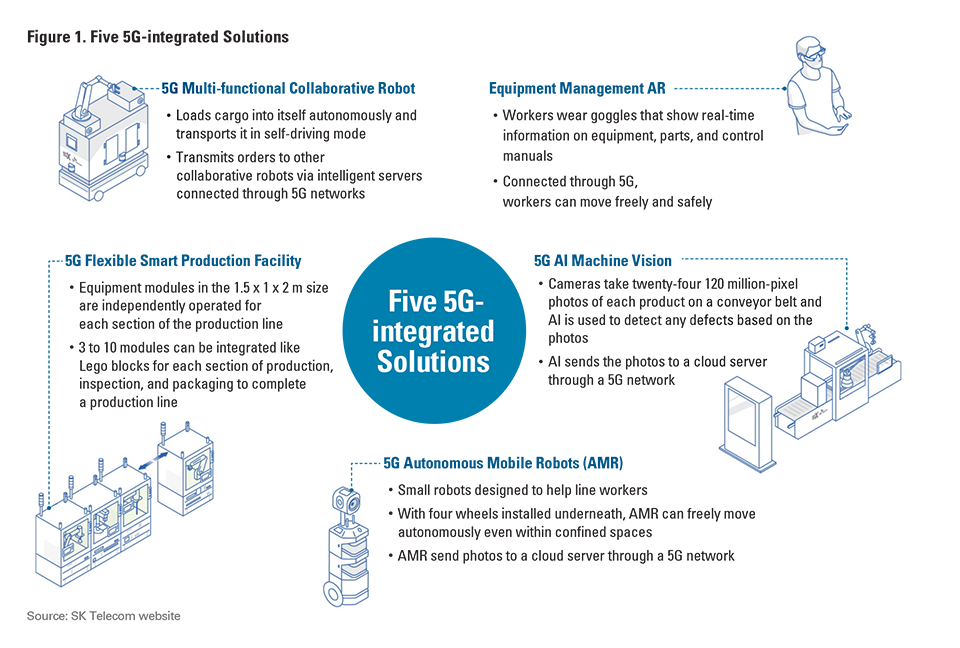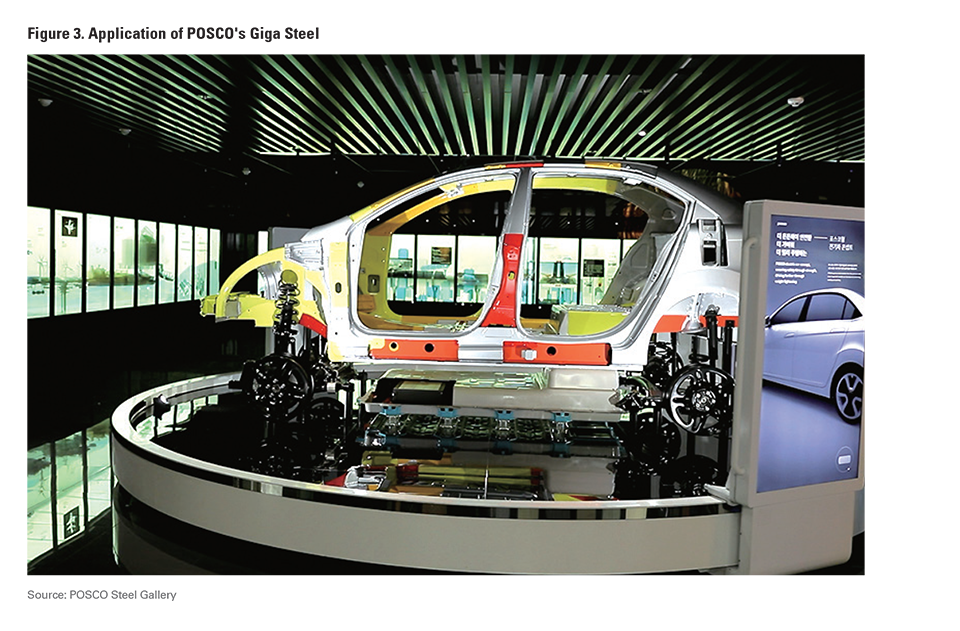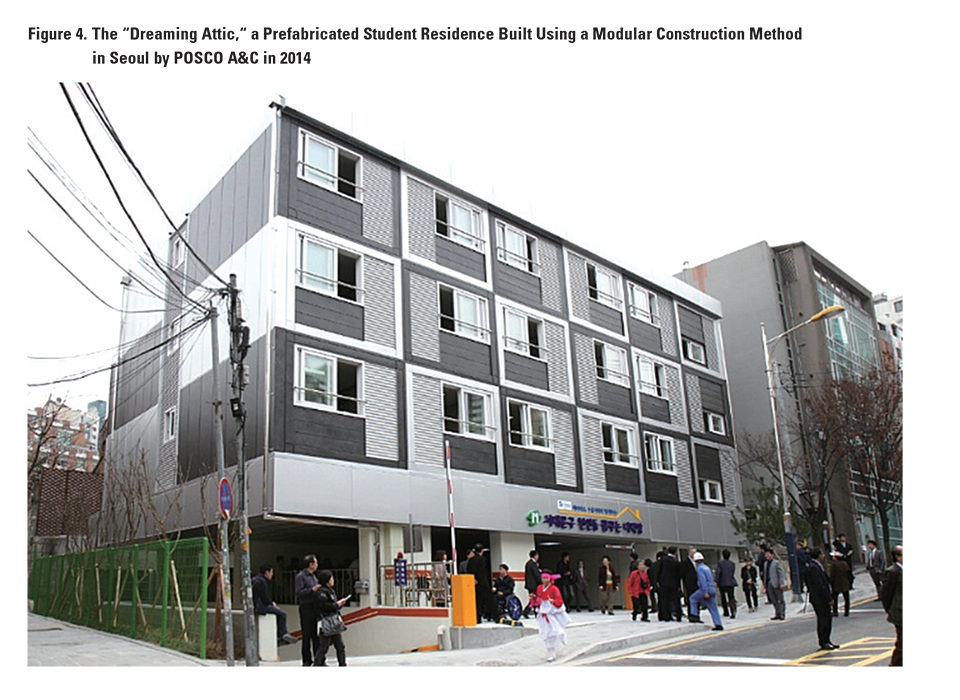The recent rollout of the 5G mobile network is expected to enable truly automated factories. It’s an opportunity to improve manufacturing processes by boosting connectivity through smart technologies like smart sensors and real-time transmissions.
Even for POSCO, who received the World Economic Forum recognition as a “lighthouse factory” for its innovative leadership in manufacturing, the 5G network is a new daunting challenge — but it’s also an opportunity. How?
Asian Steel Watch, the biannual English journal specialized in the Asian steel industry, can provide key insights. ASW vol. 7 addresses central issues surrounding the rise of the 5G network and how the steel industry can create a competitive advantage amid this new technology development. POSCO Newsroom presents Asian Steel Watch, “Shifting Needs for Steel Materials with the Rise of 5G Telecommunications and Smart Cities.”
On April 3, 2019, former Olympic figure skating champion Yuna Kim became the world’s first 5G subscriber. If we consider history to be about the conquest of materials by human beings, the advent of 5G technology heralds an era in which humans finally transcend time. We can now overcome any lag in the receipt or transmission of information anywhere around the world. 5G networks are not yet fully operational, and the effects of 5G technology are still being realized, but it will not take much longer before subscribers are enjoying full-fledged 5G services.
On June 27, 2018 when South Korea and Germany faced off in a World Cup match in Russia, shouts rose up in Seoul four times due to the time lag: Those watching on TV first cried out in triumph with the two Korean goals, followed quickly by those watching via the internet. In fact, those cheering in Seoul, whether through TV or the internet, saw the goal slightly later than those watched at the stadium in Russia. Such time lags will vanish with the advent of 5G telecommunications. Humans can finally transcend time.
Is it too much to say that a time lag might result in errors in industrial fields? When autonomous robots detect an error and halt operations at a plant, there is a time lag before the signals detected by sensors can be processed and transmitted to the control unit. Arithmetic units and programs must be installed in equipment to address this issue, causing the size and cost of equipment to rise. When equipment is managed online using the cloud, the size and cost of the equipment required can be reduced significantly. Time matters in this case. If equipment can become quicker than human reaction time, this would be an important breakthrough.
Generally, the control center must be placed within a steel plant to allow it to control the process without a time delay. However, if signals can still be transmitted faster than human reactions, the control center does not have to be located within the steel plant itself. In fact, one control center could oversee several plants of the same type. What about meetings in the workplace?
These days many companies hold remote meetings. Although theoretically feasible, remote video conferencing can still become inconvenient when the transmission speed for video and sound cannot support a reasonable time delay. This issue can be addressed through 5G technology. With video conferencing, people might feel like they are talking to one another face-to-face without any time lag. If this can be combined with three-dimensional holographic imaging, it will feel like talking to a real person even if they are actually on the other side of the world.

The commercialization of 5G technology will bring rapid changes to people’s lives. The first might be an expansion of shared offices. As shared offices are now generally used only for specific businesses, the impact of shared offices has been relatively minimal. If large companies and public institutions install shared offices near residential areas serving their employees, shared offices could have a significant impact on society.
In major cities like Seoul, Tokyo, and Beijing, workers will no longer have to spend as much time on the road. They can go to shared offices near their homes and hold remote meetings through holographic communication with their headquarters. Today, it is common to share desks at a workplace. It will not take much time to transition from desk sharing to office sharing. People will enjoy greater business opportunities as they encounter people from different teams or companies. The declining number of commuters will reduce traffic volumes. Fine particulate matter, recently a hot-button issue in South Korea, can also be mitigated to some degree. Fewer people will buy cars as they perceive less need to own them. This is evidenced by the fact that car sales are slipping in New York, Tokyo, and other large cities. Even the number of drivers’ licenses being issued is falling. With the spread of 5G technology, autonomous cars will become ubiquitous and shared cars will emerge as a norm, transforming the landscape for the automotive industry.

Autonomous cars are already a future realized. Autonomous cars collect traffic information to find optimal routes and detect road risks by monitoring the movement of nearby cars with active sensors. Intelligent autonomous car technology will advance with the significant improvement in the speed of telecommunication to cloud servers responsible for processing information using big data. 5G technology will help complete the real-time intelligent driving control systems required for autonomous cars.
Autonomous cars are already a future realized. Autonomous cars collect traffic information to find optimal routes and detect road risks by monitoring the movement of nearby cars with active
sensors. Intelligent autonomous car technology will advance with the significant improvement in the speed of telecommunication to cloud servers responsible for processing information using big data. 5G technology will help complete the real-time intelligent driving control systems required for autonomous cars.
Changes over the upcoming years or decades will be more significant than those that occurred during the last century. People’s ways of life will alter. Such changes in society will disrupt the order of conventional production and consumption and result in a new order. This new arrangement will in turn generate new demand. The question is who will seize this opportunity first. In the materials industry, companies that take a preemptive approach to this new order will certainly take the lead.
On the other hand, the Korean Institute of Metals and Materials (KIM) has selected five future materials-related issues and suggested promising materials for development. Their five
issues are: adaptation to a ‘new climate regime’; preparation for a super-aged society; disaster prevention; continuous economic growth; and a hyper-connected society. KIM has proposed types of materials to suit these five issues: materials adaptable to climate change, wellness bio-materials, safe materials, sustainable materials, and smart materials. For the steel industry, future materials adaptable to climate change, safe materials, and sustainable materials will all rise in importance. The changes in society triggered by 5G technology are closely related to the construction of smart cities using the future materials.
l The Rise of Future Metropolitan Cities
Metropolitan cities are essentially comprised of business and residential districts. In the morning, people travel long distances from residential to business areas and reverse the trip every evening. Such long-distance
commuting will disappear if shared or co-working offices become commonplace near public transportation terminals. In Korea, numerous knowledge industry centers have already been established near subway transfer stations to be used as shared offices. People could go to shared offices in the suburbs near their homes, creating new business opportunities through interaction with people from other companies. Unlike in the past when people worked with the same group of persons in the same office, they can encounter others from diverse fields of business, helping them become more creative. Time once spent on commuting can instead be used for self-development and leisure. Sports and entertainment facilities, including theaters, indoor sports centers, and tennis courts, will expand, and small businesses will flourish as they serve community residents. Such towns will require different types of buildings, and reconstruction projects refurbishing old town centers will gain ground. Once again, steel will present itself as the most suitable material for construction to proactively adapt to a rapidly changing society. The mandatory 52-hour workweek, rising labor costs, and burdensome environmental restrictions in the construction field will provide steel an opportunity to regain the position as the favored construction materials that it lost to concrete. In Great Britain, where steel is widely used for building, it is easy to procure steel components for construction. However, this industrial structure is less mature in Korea and other Asian countries where concrete buildings can easily be built due to low labor costs. This is one of the main reasons why it is essential to develop new steel construction materials in various types. Moreover, the steel industry should carefully consider how to inform consumers about the advantages of steel as a construction material: providing safety and convenience with resistance to Kim Nan-do, ‘Trend Korea 2019’ both natural (typhoons, earthquakes, tsunamis, etc.) and human-caused disasters (war, terrorism attacks, fires).
l Establishment of New Logistics Systems
Although human mobility may decline, the volume of cargo transport is projected to increase. The flourishing of e-commerce businesses such as Amazon has ensured that the logistics industry will become one of the most important industries in the future. SoftBank Chairman Masayoshi Son, who has gained remarkable returns from his investment in the Chinese web retailer Alibaba, has recently invested in Korea’s e-commerce firm Coupang, underlining the importance of the e-commerce field. To suit the rise in both dual-income and single-person households in Korea, even fresh products can be now delivered to homes. For rapid delivery of major volumes of fresh vegetables, fruit, and dairy products, it is necessary to develop new kinds of transportation systems that connect farms and cities. What is important here is how we can improve energy efficiency and reduce fine particulate pollution in a future where massive logistics becomes the norm.
The best way to improve energy efficiency is to reduce the weight of the given transport mode. Materials development in transportation, including cars, trains, ships, and airplanes as well as
drones, is primarily focused on weight reduction as a means to improve energy efficiency. Steel has long been advantageous compared to other materials, but it is being challenged by other lightweight materials. Especially for the automotive industry, improved fuel economy has become a pressing issue under increasingly strict environmental standards. The US government plans to require US vehicles to achieve fuel economy of 23.9 km/l by 2025, while Europe and Japan have set fuel economy targets of 26.5 km/l and 20.3 km/l, respectively, by 2020. Korea also plans to meet the fuel economy target of 24.3 km/l by 2020. This means that the automotive industry must improve fuel economy by more than 50% on average by 2025.

The steel industry is preparing for this situation by developing next-generation automotive steel. One example is high-strength Fe-Mn-Al-C lightweight steel, which is made over 10% lighter than conventional Fe-Mn-C steel through the addition of 5-10% aluminum content, and thereby becoming more competitive than aluminum on its own. Lightweight steel commonly has a disadvantage of having less than 1 GPa grade tensile strength. In order to overcome this, precipitation hardening martensite steel is being developed, and analysis is underway on the utilization of retained austenite. Aluminum is one of the fastest growing materials for use in vehicles, and carbon fiber reinforced composites and titanium are increasingly being applied as aerospace materials. Steel is used for aircraft landing gear, but the scope of application of steel is falling. To reduce the weight of high-speed trains, the share of the steel frame in railway rolling stock is declining and high-strength aluminum extrusion alloys and aluminum plate are on the rise in lightweight frames. Recently, extensive research is being conducted for saving weight in frames and internal materials using ignition-proof magnesium alloy. The TGV Duplex is the first high-speed train using AZ91 magnesium alloy for seat components, and it has reduced body weight by 16.7% compared to conventional aluminum alloys. Korea’s highspeed train KTX also uses magnesium alloy for seat components to achieve a weight reduction of up to 35.6%. In the shipbuilding industry, steel is increasingly being replaced by corrosion-resistant aluminum alloys in both high speed and leisure vessels. For the logistics industry, when the cost of energy for transporting a certain volume of cargo exceeds the cost of the materials in the transport, a wider range of choices of materials will be available. Under these changing trends, aluminum, magnesium, and titanium had growth rates of 9.2%, 8.0%, and 6.3%, respectively, in 2014, according to the market research firm, Markets and Markets.
In an effort to reduce fine particulates, transport modes that burn fossil fuels within cities may be edged out of the logistics industry. A so-called hyperloop, which is a future high-speed transportation concept first proposed by Elon Musk, could be used for long-distance travel while electric vehicles (EVs) or drones could be applied for short-distance travel and rapid delivery. Due to their considerable battery weight, weight reduction is an important issue for EVs. The steel industry is actively working to meet this need with advanced high strength steels (AHSS). Steel pipes seem to be the most suitable material to create a hyperloop for cargo transport. Although a hyperloop designed to carry passengers may require alternative materials to ensure psychological relief for passengers as they may feel
uncomfortable inside opaque steel tubes, steel is the most competitive option in terms of cost for a hyperloop for cargo transport. Eco-friendly container vessels or transcontinental trains can be used for transport of transnational and transcontinental cargo. The Korea Railroad Research Institute has recently developed foldable containers to improve logistics efficiency. These types of efforts will continue to become increasingly visible in various areas of logistics.
l Suitable Urban Systems
Older cities around the world share one thing in common: they have difficulty raising the massive funds required for urban regeneration. As buildings have a life cycle spanning more than 100 years, reconstruction costs are not generally included when calculating their construction costs, passing the buck down to future generations. As a result, major cities around the globe are experiencing fatigue. For a more sustainable urban system, regeneration costs must be considered from the start. Urban design should take the optimization of urban energy consumption and recycling into account. Steel is clearly the most competitive material for sustainable urban design. As nearly 80% of a steel house is recyclable, steel can be considered the base material most suitable for sustainable cities.2 If materials development puts its highest priority on energy reduction and resource circulation, the reduction of the weight of high strength steel can be a solution. POSCO A&C, a comprehensive architectural service company fully financed by POSCO, has recently developed modular housing and other structures, but the high price tag of the design in its early stages is keeping consumers at bay. The development of modular buildings would require a dramatic shift, for example, by adopting new steel materials such as printed color steel sheet. Such newly developed steel materials should be resistant to earthquakes, typhoons, and fires. Further technological advances should be pursued to address problems at a competitive price, including floor noise and thermal insulation.

▲ POSCO A&C website
l Needs for Innovation of Steel Materials
Historically, the advancement of scientific technologies has resulted in social transformations. It was only after the Industrial Revolution that workplaces became separated from places of residence. Apartments, the most common residential spaces in Korea, have been built to accommodate ballooning numbers of urban workers. The Industrial Revolution has brought profound changes to lifestyles that had been stable for centuries. In the First Industrial Revolution, steam engines created value through mass production. In the Second and Third Industrial Revolutions, the introduction of electricity and IT-based automation technology resulted in breakthroughs in production. Mass production cut costs and eventually expanded markets and increased sales. However, at the same time, it led to the reckless use of energy and resources, giving rise to several environmental and social issues. The Fourth Industrial Revolution, known for its data revolution, will also drive seismic changes in the lives of people with the advent of 5G telecommunications that can better apply the full value of data. Customized mass production is fundamentally addressing the issue of the resources wasted in mass production, while at the same time changing ways of life. The previous industrial revolutions separated work from places of residence, but the Fourth Industrial Revolution will return workspaces to residential areas. Perhaps the distant and even broken relations among families and neighbors can be restored. New communities can be created. Novel opportunities will arise for some of the sectors of society overlooked in the past. The issue is now a matter of who will react preemptively to these changes. Time is running out: A seismic change in society is just around the corner. The steel industry’s capacity to adapt to this change will be tested. The industrial revolutions of the past have transformed the lives of people, and those well prepared for such transformations have seized the opportunities they created.
* This article has been reproduced from Asian Steel Watch, a bi-annual English journal specialized in the Asian steel industry. The original version Vol. 7 (2019.08) can be accessed and downloaded directly from POSRI’s website here.













